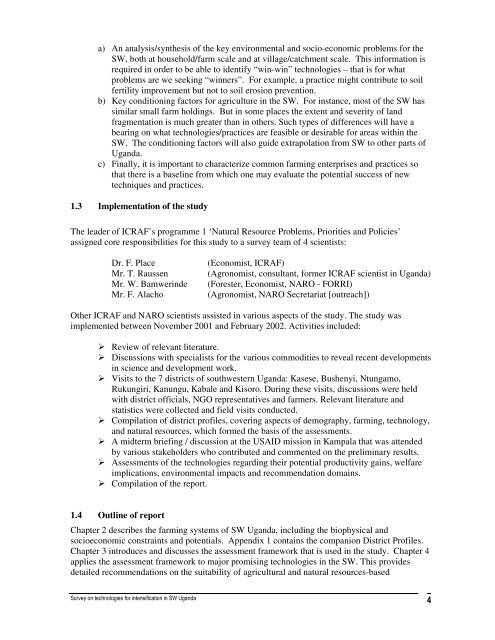Technologies for intensification in SW Uganda ... - Foodnet - cgiar
Technologies for intensification in SW Uganda ... - Foodnet - cgiar
Technologies for intensification in SW Uganda ... - Foodnet - cgiar
You also want an ePaper? Increase the reach of your titles
YUMPU automatically turns print PDFs into web optimized ePapers that Google loves.
a) An analysis/synthesis of the key environmental and socio-economic problems <strong>for</strong> the<br />
<strong>SW</strong>, both at household/farm scale and at village/catchment scale. This <strong>in</strong><strong>for</strong>mation is<br />
required <strong>in</strong> order to be able to identify “w<strong>in</strong>-w<strong>in</strong>” technologies – that is <strong>for</strong> what<br />
problems are we seek<strong>in</strong>g “w<strong>in</strong>ners”. For example, a practice might contribute to soil<br />
fertility improvement but not to soil erosion prevention.<br />
b) Key condition<strong>in</strong>g factors <strong>for</strong> agriculture <strong>in</strong> the <strong>SW</strong>. For <strong>in</strong>stance, most of the <strong>SW</strong> has<br />
similar small farm hold<strong>in</strong>gs. But <strong>in</strong> some places the extent and severity of land<br />
fragmentation is much greater than <strong>in</strong> others. Such types of differences will have a<br />
bear<strong>in</strong>g on what technologies/practices are feasible or desirable <strong>for</strong> areas with<strong>in</strong> the<br />
<strong>SW</strong>. The condition<strong>in</strong>g factors will also guide extrapolation from <strong>SW</strong> to other parts of<br />
<strong>Uganda</strong>.<br />
c) F<strong>in</strong>ally, it is important to characterize common farm<strong>in</strong>g enterprises and practices so<br />
that there is a basel<strong>in</strong>e from which one may evaluate the potential success of new<br />
techniques and practices.<br />
1.3 Implementation of the study<br />
The leader of ICRAF’s programme 1 ‘Natural Resource Problems, Priorities and Policies’<br />
assigned core responsibilities <strong>for</strong> this study to a survey team of 4 scientists:<br />
Dr. F. Place (Economist, ICRAF)<br />
Mr. T. Raussen (Agronomist, consultant, <strong>for</strong>mer ICRAF scientist <strong>in</strong> <strong>Uganda</strong>)<br />
Mr. W. Bamwer<strong>in</strong>de (Forester, Economist, NARO - FORRI)<br />
Mr. F. Alacho (Agronomist, NARO Secretariat [outreach])<br />
Other ICRAF and NARO scientists assisted <strong>in</strong> various aspects of the study. The study was<br />
implemented between November 2001 and February 2002. Activities <strong>in</strong>cluded:<br />
Review of relevant literature.<br />
Discussions with specialists <strong>for</strong> the various commodities to reveal recent developments<br />
<strong>in</strong> science and development work.<br />
Visits to the 7 districts of southwestern <strong>Uganda</strong>: Kasese, Bushenyi, Ntungamo,<br />
Rukungiri, Kanungu, Kabale and Kisoro. Dur<strong>in</strong>g these visits, discussions were held<br />
with district officials, NGO representatives and farmers. Relevant literature and<br />
statistics were collected and field visits conducted.<br />
Compilation of district profiles, cover<strong>in</strong>g aspects of demography, farm<strong>in</strong>g, technology,<br />
and natural resources, which <strong>for</strong>med the basis of the assessments.<br />
A midterm brief<strong>in</strong>g / discussion at the USAID mission <strong>in</strong> Kampala that was attended<br />
by various stakeholders who contributed and commented on the prelim<strong>in</strong>ary results.<br />
Assessments of the technologies regard<strong>in</strong>g their potential productivity ga<strong>in</strong>s, welfare<br />
implications, environmental impacts and recommendation doma<strong>in</strong>s.<br />
Compilation of the report.<br />
1.4 Outl<strong>in</strong>e of report<br />
Chapter 2 describes the farm<strong>in</strong>g systems of <strong>SW</strong> <strong>Uganda</strong>, <strong>in</strong>clud<strong>in</strong>g the biophysical and<br />
socioeconomic constra<strong>in</strong>ts and potentials. Appendix 1 conta<strong>in</strong>s the companion District Profiles.<br />
Chapter 3 <strong>in</strong>troduces and discusses the assessment framework that is used <strong>in</strong> the study. Chapter 4<br />
applies the assessment framework to major promis<strong>in</strong>g technologies <strong>in</strong> the <strong>SW</strong>. This provides<br />
detailed recommendations on the suitability of agricultural and natural resources-based
















